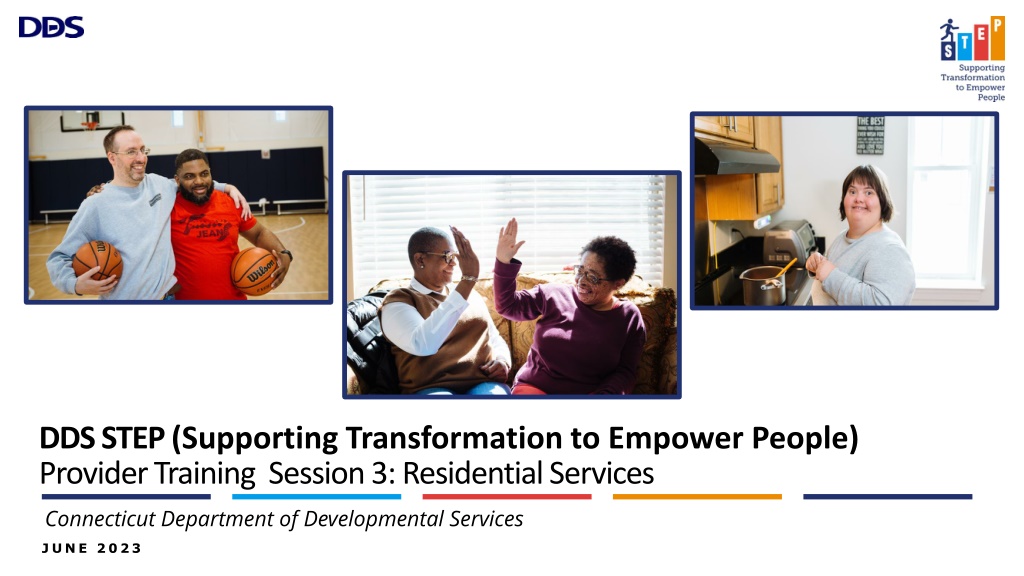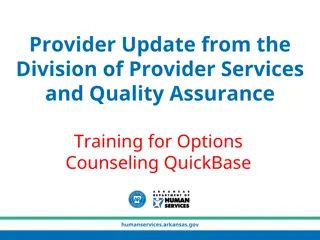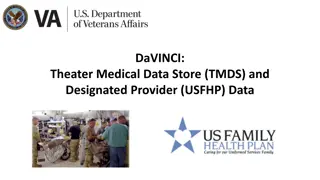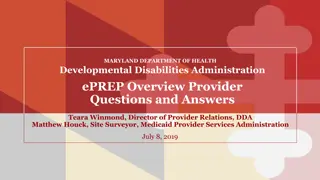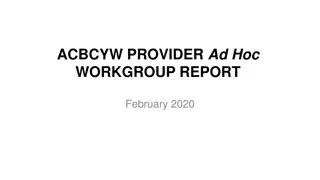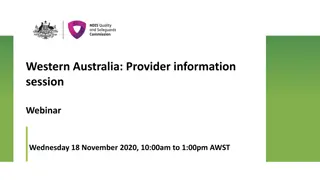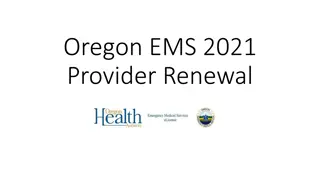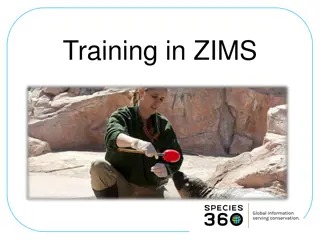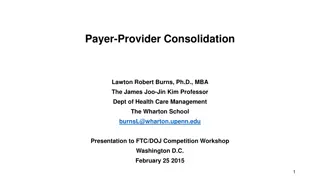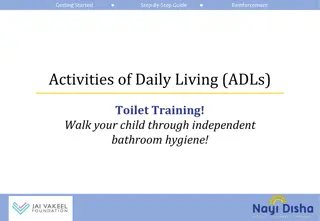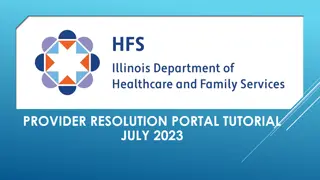Empowering People Through STEP Provider Training
STEP (Supporting Transformation to Empower People) Provider Training Session aims to equip residential service providers with the knowledge and tools to support individuals in their transition towards independence. The training covers topics such as financial incentives, transition planning, and building plans based on sample templates. STEP emphasizes empowering individuals to align their life experiences with personal goals, fostering independence, and prioritizing person-centered processes. Providers play a crucial role in driving forward the STEP initiative by creating transition plans that support individual needs and aspirations. Attendees are encouraged to engage in information sharing, develop creative strategies, and collaborate with individuals and their families throughout the transition process.
Download Presentation

Please find below an Image/Link to download the presentation.
The content on the website is provided AS IS for your information and personal use only. It may not be sold, licensed, or shared on other websites without obtaining consent from the author. Download presentation by click this link. If you encounter any issues during the download, it is possible that the publisher has removed the file from their server.
E N D
Presentation Transcript
DDS STEP (Supporting Transformation to Empower People) Provider Training Session 3: Residential Services Connecticut Department of Developmental Services J U N E 2 0 2 3
Zoom Tips Click Show Captions to turn captions on Click Start Video to turn on your camera Click Unmute to speak Click Chat to write to the group or to see what people write
Agenda Welcome Review and approval process Financial incentives Transition plan and budget examples Q&A and closing
Session Objectives Know how to navigate the STEP transition plan creation, submission, and approval process. 1 2 Be comfortable with the STEP Transitions Plan Templates and Budget sheet. 3 Understand how to build your plan based on sample templates and budgets.
STEP is an incredible opportunity to empower the people we support through strategic investments in the DDS system. Building on Charting the Life Course priorities, STEP emphasizes a different way of thinking that encourages high expectations, emphasizes life experiences that align with individuals goals, and the integration of multiple support types to build independence. Individuals and their Families Providers DDS Work to develop a vision for their life and build skills and natural supports for lifelong independence according to their goals, interests, and strengths. Create more support options for individuals that give them opportunities to connect their residential and working lives to their goals and needs. Develop an organizational approach that prioritizes person-centered processes and supports individuals to be independent and self- determined.
Provider Role Providers are the on the ground driving force of STEP! Provider transition plans directly create the opportunities for individuals to transition. Resources to help you submit plans and answer questions! 1. Consider STEP incentives as part of agency planning. How can you leverage this financial opportunity to best support individuals? 2. Support information sharing and discussions with individuals and their families about transitions. Provider Gateway:STEP Resources Visit the Technical Assistance Request Link for technical support or to learn more about STEP 3. Develop creative approaches and strategies so individual can transition to supports that are right for them and emphasize independence and choice. 4. Create transition plans and coordinate with your region, updating as necessary or requested by your region. Attend STEP Office Hours on Fridays from 10 11 a.m. via this link 5. Coordinate with individuals and their families and case managers throughout the transition process to ensure that it is person-centered.
Transition Plan Process Provider submits STEP Transition Plan to regional Resource Administrator Regional approval of the plan Regional review of the submitted plan Provider develops a STEP Transition Plan Provider begins transformation planning and engages Regional Staff for input and support Review team collaborates with provider for revisions to the plan as needed Provider begins implementation activities
What Are Reviewers Looking For? Transition Plan Templates each include review criteria for consistency in review across regions. Examples include: Person-centered planning processes that engage individuals and their teams Provider has the staffing capabilities to facilitate the transition and provide supports Individuals are receiving transition-specific supports Plan demonstrates an awareness and approach for addressing emotional challenges Appropriate transition timelines and milestones Transformative efforts that demonstrate long- term strategic planning
How Does DDS Make Approval Decisions? Transition Plan Templates each include review criteria for consistency in review across regions. In addition, DDS is prioritizing approval of plans that are truly transformative and innovative. A transformative plan is characterized by the type of transition and meeting at least one of the four criteria listed below: TYPE OF TRANSITION Plan for transitioning individuals from a congregate to a non-congregate, community-based setting Innovative Criteria for STEP Plans NEW PROGRAMS APPENDIX K OBJECTIVES SCALE OF IMPACT NEW APPROACH Creates or expands an agency s capacity to provide individualized supports through new programs or offerings Completes an Appendix K Objective related to restructuring a residential setting to support individuals with specialized or complex medical, behavioral, or clinical needs Tests a new approach for the agency with the potential for growth and capacity to serve more individuals The number of people or settings impacted is significant for the agency and represents real transformation
STEP Incentive STEP Incentive is a one-time incentive of $33,500 for individuals transitioning to an alternative community-based setting for at least 60 days. Scenario: Individual transitions from a CLA to IHS Incentive Calculation: Provider receives a one-time payment of $33,500 for each qualifying transition Incentive Limits: only applies to transitions in an approved Transition Plan. Must be completed before March 31, 2025.
Provider Transition Incentive Provider Transition Incentive payments for vacancies left by an individual transitioning to maintain fiscal stability during the transition. Scenario: Individual transitions from a CLA to IHS in their own apartment Incentive Calculation: (Current Annual Funding (CLA) / 12 months) x Number of Months Needed = PTI Incentive Limits: Maximum of 6 months, or until the last individual transitions out of the CLA
New Residential Placement Incentive New Residential Placement Incentive for individuals that transition from congregate living settings to independent living settings Scenario: Individual transitions from a CLA to IHS in their own apartment Incentive Calculation: (Target Annual Funding (IHS) / 52) x Number of weeks needed = NRPI Incentive Limits: Maximum of 20 weeks
Transforming Settings Through STEP, people can move to supports that are the best fit for them. This includes people who struggle to find supports because of behavioral or medical support needs, or that are on the DDS waitlist. IHS or CCH Supports CLA or CRS Using incentives to restructure settings to serve individuals with complex needs: Hire and train additional staff Invest in assistive technology and remote supports Transform physical spaces to improve accessibility Individuals on the DDS residential waitlist and/or individuals with significant behavioral or medical support needs Backfilling CLA/CRS settings If a provider backfills a CLA/CRS setting following a transition, that individual must be from the DDS waitlist or approved by DDS as having significant behavioral or medical support needs for the transition to be eligible for STEP incentives.
STEP Residential Transition Template 2 3 1 Transitioning from a CLA or CRS to a more integrated community-based setting (own home, family home or CCH) Transition Plan Instructions Template A: Residential Budget Sheet Optional: Template A2: Additional Settings We will now screenshare to walk through the template in detail! Example Transition Plans are on the Provider Gateway
Resources Looking for information about STEP to share with individuals and their families? Check out the new public STEP Page Looking for more information about STEP? Check out the STEP Resources page on the DDS Provider Gateway on www.ct.gov/step on DDS Provider Gateway
